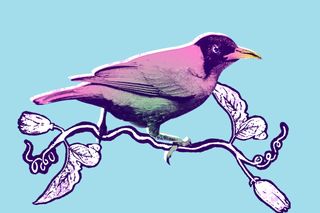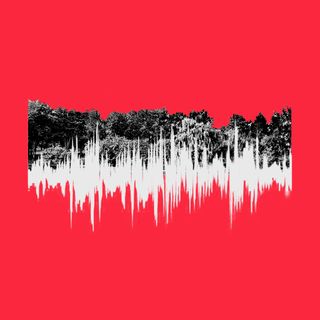
A Bird Sighting Just Reaffirmed That Nature Is Queer
The half-male half-female Green Honeycreeper joins the ranks of genderqueer lionesses, the "Leaping Lesbian Lizard,” and other "drag queens in the sky."

Hamish Spencer, zoologist and Distinguished Professor at the University of Otago, was on holiday in Colombia when ornithologist John Murillo drew his attention to a striking bird at a bird-feeding station in a nature reserve. Save for a few feathers here and there, this Green Honeycreeper seemed to be neatly divided down its middle with brilliant blue plumage – resembling males of the species – on its right side, and green plumage – observed in females – on its left. The two watched this bird between the end of 2021 and mid-2023, observing its behavior in relation to other members of its species. As their report notes, this bird is only the second example of “bilateral gynandromorphism” in this species – a trait where animals present with both male and female characteristics in species that usually have distinct sexes.
This “extremely rare,” half-male and half-female bird soon made headlines. After all, it was the first record of this phenomenon in this species in over a 100 years. But this sighting also reiterated what some scientists have long been pointing to – that our understanding of sex as a biological binary of male and female may, in fact, be a simplistic reduction of a far more complex reality.
“Many birdwatchers could go their whole lives and not see a bilateral gynandromorph in any species of bird,” Spencer said in a statement. While considered rare, this trait has previously been observed in spiders, bees, butterflies, lizards, and stick insects among others. Scientists have also found these seemingly gender binary-defying individuals in other bird species, such as the northern cardinal (a non-binary icon, according to X) and the rose-breasted grosbeak. The northern cardinal even inspired Pattie Gonia, an environmental drag activist, to create a look based on it. “We see queerness and gender queerness demonstrated in birds like the [chimera] cardinal so vividly… Birds are drag queens in the sky,” Gonia told Audobon Magazine.
In its most simplistic form, sex in humans seems to hinge upon the presence or absence of the Y chromosome, which determines the reproductive organs one possesses. Sex, according to this understanding, casts individuals as either male or female and is one of the foundational pillars upon which our society has been constructed – prescribing roles, granting opportunities, and determining whose rights are championed and whose sidelined. But several scientists have pointed out that sex as a binary is false. Arthur Arnold, a biologist at the University of California, Los Angeles, told Scientific American in 2018, “The main problem with a strong dichotomy is that there are intermediate cases that push the limits and ask us to figure out exactly where the dividing line is between males and females… And that's often a very difficult problem, because sex can be defined a number of ways.” That is, sex in humans (as in animals) is far more complex.
Agustín Fuentes, a professor of anthropology at Princeton University, pointed to emerging research data that shows how binary explanations of human sex “are either wholly incorrect or substantially incomplete.” Biology has been wielded as a tool to exclude queer people. Fuentes writes, “Given what we know about biology across animals and in humans, efforts to represent human sex as binary based solely on what gametes one produces are not about biology but are about trying to restrict who counts as a full human in society.”
Look to the natural world and countless examples emerge to challenge the fallacies around sex, gender and sexuality. These examples call into question what humans have long considered “natural.” It is an idea inherent in the field of queer ecology that draws upon the ecofeminist movement and expands it beyond binary thinking, instead championing a more fluid and diverse understanding of the world, and our relationship with it. Nature, as countless species show, is queer.
Take the clownfish, for instance. They live in groups where only two – the dominant male and female are mates. When the female dies, the male changes its sex to become female before selecting the next male from the group to become its mate. Male bearded dragons, meanwhile, reverse their sex under warm temperatures to become female while still within the egg. Banana slugs are “simultaneous hermaphrodites” – they possess and use both their male and female reproductive organs to mate with a partner or even themselves. In Botswana, five gender-queer lionesses alarmed scientists when they grew a mane and developed male-like behaviors, including a deeper roar and mounting other females. Then there is the New Mexico lizard, which is a species that entirely comprises females. They mate, lay eggs and reproduce like others. According to scientists, this is a form of asexual reproduction known as parthenogenesis. Just like the “non-binary” cardinal, this lizard – also referred to as “Leaping Lesbian Lizard,” also became a queer icon, inspiring not only art, but even a Pokémon and the name of a college frisbee team.
A key way in which nature challenges the heterosexual ideal is through the sheer prevalence of same-sex behavior. Homosexuality, reports say, has been documented in 1500 species – from dolphins and giraffes to penguins and starfish. It’s ironic when viewed historically, where the supposed absence of homosexuality in animals has been used time and again to fuel homophobia and deem homosexuality a “crime against nature” itself. The emperor penguin, for instance, was lauded by American conservatives as upholding traditional family values after a film depicted them in monogamous relationships. Penguins, however, may be socially monogamous, but aren’t so sexually, Eliot Schrefer, author of “Queer Ducks (and Other Animals): The Natural World of Animal Sexuality,” wrote in The Washington Post. Some may even be bisexual, Schrefer noted. Just last year, a pair of male penguins successfully fostered an egg at the Rosamund Gifford Zoo in New York, while in 2019, another pair of male penguins at the Berlin zoo co-parented an abandoned egg after having attempted to hatch stones and even a dead fish.
Same-sex behavior across species also challenges the prevailing notion that sex in the natural world only occurs for the goal of reproduction. Instead, there are many reasons for same-sex behavior – from building social bonds and resolving conflict to simply gaining pleasure. Recently, a lot more research has emerged on same-sex relationships in nature, perhaps due to changing gender norms. In the past, observations of same-sex behavior had scientists either decrying it as “depravity” or avoiding publishing findings, due to their own biases or to prevent disapproval from the scientific community, noted Schrefer.
As Ingrid Bååth wrote in Climate Culture, “Not only does our understanding of nature become the baseline for what we believe to be natural, but also what we believe to be moral or good behaviour… We interpret nature based on our inherent biases and use our biased understanding of nature to defend and justify those societal biases we have.”
These biases stem from predominantly Western notions of gender and sexuality that have been imposed upon the human and nonhuman worlds, Willow Defebaugh noted in Atmos. It creates dualities of “opposing” categories – pitting humans against nature, man against woman – separating one from the other in a power hierarchy. “Binary thinking, in any form, is rooted in a Western colonial view of the world in which one must always be subjugated by the other,” Katy Constantinides wrote for Climate Policy Lab.
A queer ecological framework, on the other hand, shows us that there is no one way to be masculine or feminine and that these categories may not exist in nature as we know it. It positions humans as a part of nature rather than distinct from it, leveling the power dynamics from an extractive to a community-oriented one. Nature is fluid, queer, and resists categorization as per human cultural perceptions and biases. As queer ecologists point out, acknowledging that may be the first step to repairing our relationship with the natural – as well as human – world.
Ananya Singh is a Senior Staff Writer at TheSwaddle. She has previously worked as a journalist, researcher and copy editor. Her work explores the intersection of environment, gender and health, with a focus on social and climate justice.
Related

.jpg?rect=0,80,1280,1280&w=320&h=320&fit=min&auto=format)
The World Bank Wants to Incentivize Climate Capitalism
